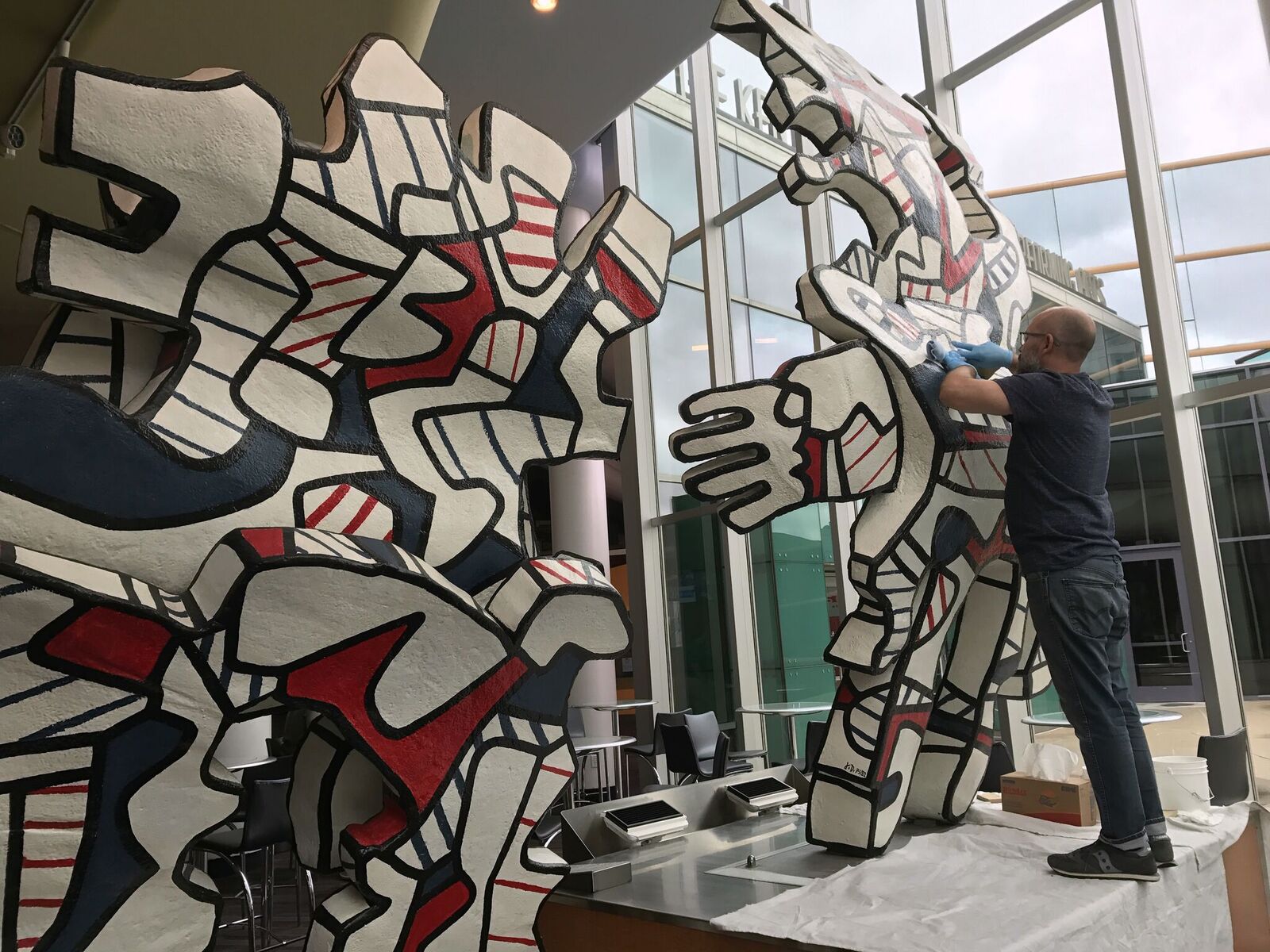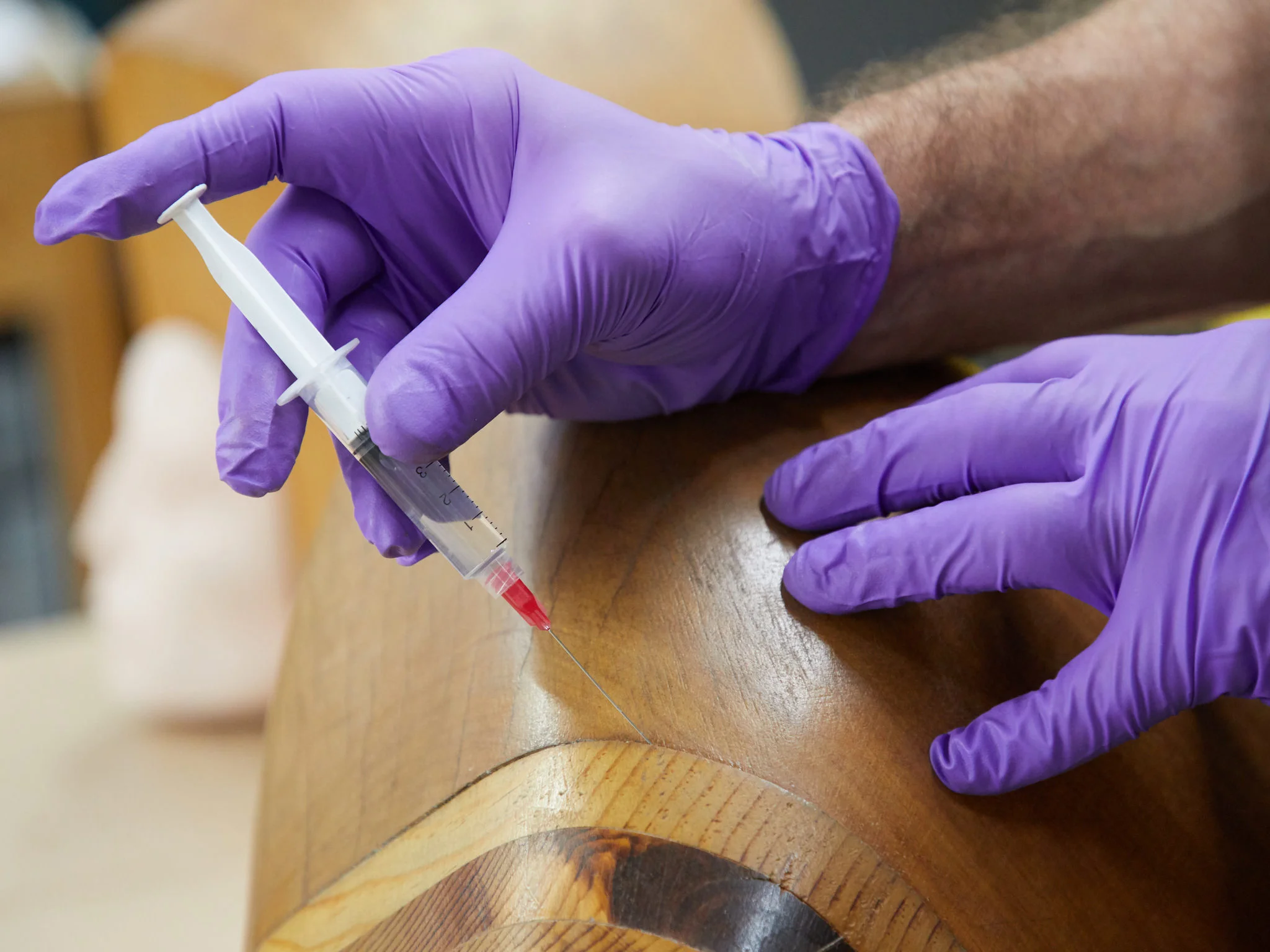Although he is widely recognized for his paintings, Salvador Dali completed a number of series featuring lithographs and etchings. When one of such works came to The Center for care, we were excited to work on such a special piece. This print, titled "Dalinean Prophecy", is number 8 of 25 in a series called “Imagination and Objects of the Future”.
Organization and Conservation: The Center's Inventory Process
Organization and efficient inventory management are of the utmost importance here at The Conservation Center. It is critical for our staff to properly record each piece as it enters and exits our facility, especially with the recent influx of delicate items from our disaster response efforts. So how do we stay organized?
New Treatment Techniques: Conserving a Photo Canvas by Balthasar Burkhard
When this piece first came to The Center, it was rolled on a tube and our client thought it was a painting. However, it wasn't long before the work’s true story began to unfold. Our client had recently purchased the large-scale piece from its long-term owner and knew the work was in need of care. The piece had been on display in a private residence for many years using metal clips at the top two corners. The installation on the wall was similar to how the artist had displayed the work in previous exhibitions. The corners where the sheet had been hung exhibited areas of stress and tears. These same areas exhibited what appeared to be oxidized rust stains that were caused by the metal clips.
A Dramatic Scene and a Minimal Treatment: Conserving an Irving Penn Photograph
When this piece came to The Center, we knew there was a story behind it. When we asked our client, he was happy to share. “The work is from 1946, and is part of a series of photographs that Irving Penn did for Vogue,” our client explained. The photograph features Maurice Tillet and Dorien Leigh, both famous in their time but for very different reasons.
What Does That Do, Part II: Water Bathing in Conservation
In this second installment of our series exploring the tools and technologies used in the field of conservation, we will head to The Center's fourth floor lab to learn more about one of the major pieces of equipment used by the team: our custom built water washing and light bleaching station. The station allows the conservators to reduce staining and discoloration in paper without the introduction of potentially damaging chemicals.
All Roads Lead to Rome: Following the Transformation of a Family Heirloom
The ancient city of Rome and its many architectural masterpieces need no introduction, but this painting may. Depicting a charming scene of the Tiber River as it flows through Rome, this late 18th century Italian painting was brought to The Center for treatment by a client whose family hoped we could revive the color in their yellowed painting.
A Six-Panel Screen and a Panel of Conservators, Part II
The Conservation Center is fortunate to have specialists with a wide variety of backgrounds under one roof. This allows our conservators to come together frequently to analyze complex pieces and collaborate on treatments. This is especially useful when it comes to treating pieces like large, antique screens, which often require not only the expertise of The Center’s furniture conservators, but also input from The Center’s gilders, paper conservators, and objects conservators. These collaborations, which are often completed in multiple campaigns, require each party involved to dedicate hours to meticulous, step-by-step treatments. One screen, which was recently completed The Center’s team, demonstrates how valuable these types of collaborations can be.
Parks and Conservation: The Dubuque Museum of Art's Architectural Drawings
From professor and poet to author and architect, Alfred Caldwell’s long career led him on a varied journey with many paths. While Caldwell is most commonly known for his landscape designs, he also spent time working as the Superintendent of Parks in Dubuque, Iowa, as well as a professor at Chicago's Illinois Institute of Technology. Recently, these two locations from Caldwell's past met again when the Dubuque Museum of Art brought more than 80 architectural blueprints to The Center for treatment.
Timeless Design: Conserving Irving Harper's Compass Clock
When this piece came to The Center for treatment, we knew it was only a matter of time until we discovered the story behind it. After several conversations with the owner followed by some research on our end, we discovered that the clock was designed by Irving Harper for the “Motion Notion” series in 1959-1960. Often referred to as the “Compass Clock”, the timepiece was produced by George Nelson & Associates, where Harper worked as a designer for nearly seventeen years.
Take Two: Treating an Early Marisol Scene in Phases
Maria Sol Escobar, otherwise known as simply Marisol, was born in Paris to Venezuelan parents. She would later find a home in New York city, where in time her unique and varied artistic talents would make a significant mark on the art world. In the 1950s, she worked out of a small loft studio that she shared with a man name Richard Buzzle. In the evenings, she would borrow Richard’s tools. They became friends, and when it came time to part she made him a gift. The gift stayed privately within Richard’s family and was passed down through generations but never publicly exhibited. Years later, it would resurface when mentioned in a 2014 volume about Marisol’s career titled Marisol: Sculptures and Works on Paper. Most recently, it reappeared again when Richard’s daughter and granddaughter brought it to The Center for conservation.
Season's Greetings: Conserving Orignal Artwork for Holiday Cards
Giving and receiving holiday cards is a beloved tradition, bringing friends and family members from near and far together with just a simple gesture. No matter how far from loved ones you may be, opening a holiday card can make you feel close and connected to those you miss. This was the feeling that one of our clients had when he recently discovered some long-lost original artwork for old holiday cards.
What Does That Do: Gesso Carving Chisels
The field of conservation continuously evolves as new technologies are introduced and assimilated into to a conservator's toolkit. From incorporating lasers to clean stone, metal, or wood to modeling painting cleaning after gecko feet; the field of conservation benefits greatly from innovation and technique development. On the contrary, conservation is also a very old field and many techniques and tools that were used hundreds of years ago are still in rotation today. The Gilding Department is one such department where modern innovations are incorporated, however little has changed in regard to materials and techniques over hundreds of years.
Preservation for the Parish: Conserving the Holy Cross Chapel of St. Andrew Greek Orthodox Church
Recently, The Conservation Center’s team had the great honor of conserving several pieces from the interior of the Holy Cross Chapel of St. Andrew Greek Orthodox Church in Chicago’s Edgewater neighborhood. After the objects sustained water damage, The Center’s team was happy to be able to assist in the process of preserving the pieces and the historical identity of the church.
Photo Essay: “A Day in the Life” at The Center, Fall 2017
From quick triage treatments to long on-site hours, the past few months at The Center have been full of surprises. To wind down a busy season, we are bringing back our reoccurring “A Day in the Life” Photo Series. Browse the images below to see what our conservators, account managers, and shipping team have been up to both inside The Center's Chicago laboratory and beyond.
Art in the Public Eye: Treating the Fascinating Collection of Modern Art Sculptures at The Kentucky Center
This past August, two conservators from The Conservation Center traveled to Louisville, KY to conserve the vibrant collection of public art on display at The Kentucky Center for the Performing Arts.
The Kentucky Center seeks to cultivate the artistic scene in Louisville by providing programming ranging from music and theater performances to numerous outreach and education services, The permanent artworks displayed throughout The Kentucky Center feature a number of notable artists including Alexander Calder, John Chamberlain, Edgar Degas, and Joan Miro.
Send In The Conservators: Saving Circus Memorabilia
This spring at The Center, the circus was in town and you won't believe your eyes at the amazing transformation of one client's very special family heirlooms. The client's maternal grandfather, along with his father and grandfather, were part of the Galetti’s Circus, a circus that toured Europe and America in the late 19th century. The client's relatives were responsible for feeding and caring for the famous performing monkeys as the circus traveled.
The Preservation of Words: Conserving a Collection of Historical Books
At The Conservation Center, we are fortunate to have the opportunity to learn about the personal histories and meanings of the pieces and collections that are brought to us for treatment. Each piece that comes to us has a unique story to tell. When we recently received a collection of rare books damaged in a violent storm and learned about their importance to our client, we were honored to assist with the conservation of the pieces and preservation of the history and meaning they held.
Our client, an avid book collector, sought out a five-volume collection, Norman Conquest of England, after learning more about his ancestry through DNA testing. He found that he had Celtic, Scandinavian, and Viking origins. This spurred his deep interest in learning about the history of these cultures, and encouraged him to add to his book collection with rare, historical books on these subjects.
The Center's 2017 EXPO Installation
Robert Motherwell: Float Washing, Hinging, and New Housing
Untitled was brought to The Center to address age-related issues and improper housing. The sheet had been hinged directly to a linen mount and there was select off-gassing onto the glazing from printed passages of the black ink. The overall sheet exhibited darkening due to age-related discoloration caused by the presence of the linen-lined support.
Marisol Escobar: Harold Washington Library's Women Leaning
Marisol was a Venezuelan-American active in the New York art scene in the 1960s. Influenced by both her contemporaries and Pre-Colombian figures, Marisol was known for assembling figurative wooden sculptures using a variety of media.
Due to the unique media in Women Leaning, these figures were treated by The Center’s Objects, Furniture, and Paintings Departments. The figures exhibited areas of loss, and assorted condition issues such as gouges and shrinkage splits.





















